The North Vietnamese army (officially the People’s Army of Vietnam or PAVN) decided to create a tank arm in October 1959. As was the case with many Communist countries during the Cold War, the PAVN’s first tank type was the WWII-vintage T-34.

The T-34s delivered to North Vietnam from the USSR were all of the T-34/85 version, with a 85mm main gun. The North Vietnamese tanks were refurbished in the Soviet Union prior to transfer and most if not all had T-54/55-type road wheels, in addition to a newer (type 10RT) radio.

(Preserved as a monument, this Vietnamese T-34 shows the DT 7.62mm bow machine gun and also a DShK 12.7mm machine gun fitted on an external mount of Vietnamese design. The spare track links on the glacis provided a bit of extra protection.)
The T-34 weighed 35 tons and was armed with a ZiS-S-53 85mm main gun which could fire either armor-piercing or high-explosive rounds. It had a top speed of 33mph.

Heavily armored and well-designed, the T-34 is generally regarded as one of the best, if not the best, tank of WWII and even in the 1950s and 1960s was still a formidable opponent.
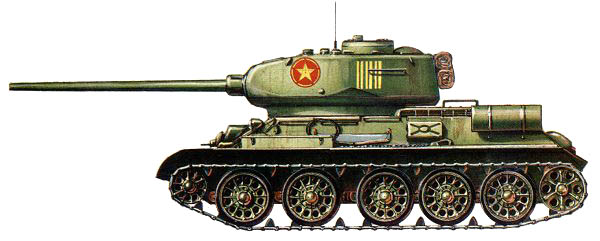

(The inside of a Vietnamese T-34, showing the sightpiece and breech of the 85mm main gun. Vietnam typically retained the standard Soviet color schemes.)
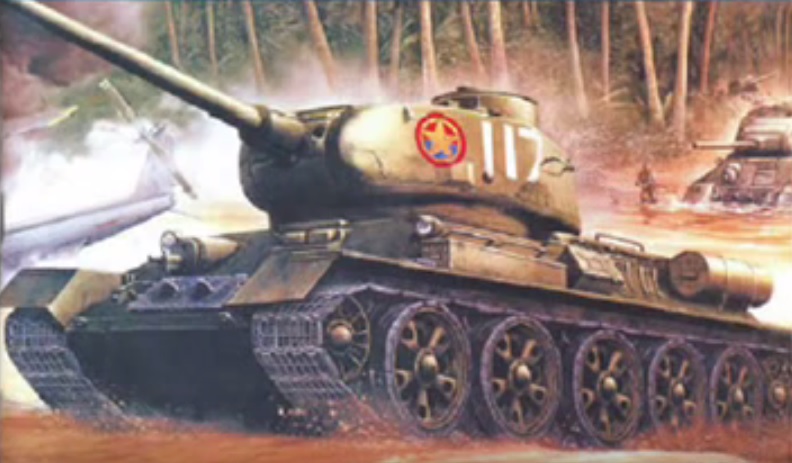
(From a Russian book on the Vietnam War, this artwork shows a T-34 in the red-blue-yellow colors of the Viet Cong. This may be the artist’s imagination, as tanks were assigned to the regular army, not VC.)
The PAVN also operated the Type 63, a Chinese-made self-propelled anti-aircraft gun (SPAAG). The Type 63 had the chassis and drivetrain of a T-34 but a thinly-armored open-top turret with a twin 37mm AA gun. The gun was optically-sighted and manually-operated, and of limited use against modern tactical strike jets. It was of course, completely useless against high-altitude B-52 Stratofortress bombers. On the other hand, it was surprisingly effective against helicopters and low-level planes like the A-1 Skyraider and A-37 Dragonfly.
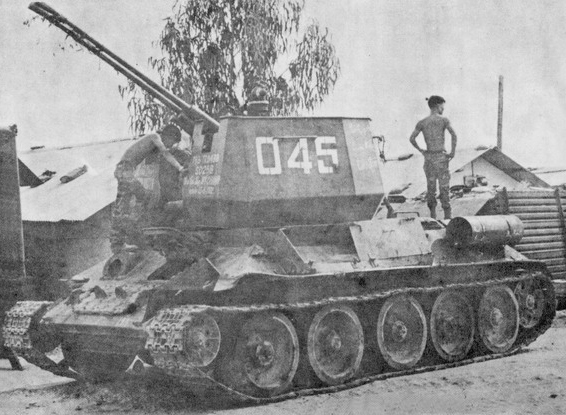
(A Type 63 SPAAG captured by South Vietnamese troops. This particular vehicle has the older-style roadwheels. All of Vietnam’s actual T-34s had the newer design common to the T-54/55.)
North Vietnam’s other tanks
By the start of the main American involvement in the Vietnam War, the T-34 had already been pushed to the lowest tier of North Vietnamese armor. The main North Vietnamese tank was the Cold War-era T-54/55 of Soviet manufacture. North Vietnam also used the Type 59, a Chinese-made clone of the T-54/55.

(South Vietnamese infantry pose on a captured North Vietnamese Type 59; the Chinese copy of the Soviet T-54/55. North Vietnam used both types, with the T-54/55 being more common. The infantrymen are wearing the WWII-era M1 steel pot which was the ARVN’s standard helmet it’s whole existence.)
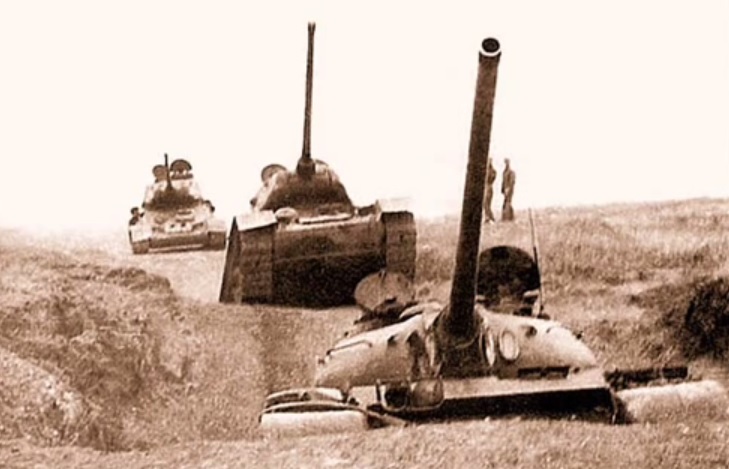
(A North Vietnamese T-54/55 leads two T-34s during a training exercise in the 1970s.)
North Vietnam also used the Cold War-era PT-76 amphibious tank, also a Soviet design. This lightly-armored tank was more suitable for scouting and infantry support than direct tank vs tank battles.
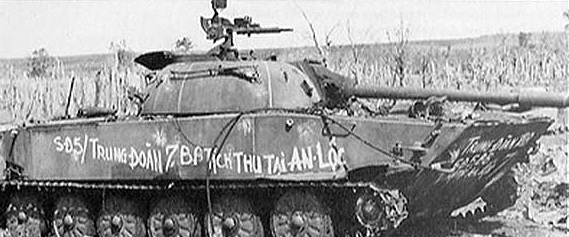
(A North Vietnamese PT-76 which was knocked out by a M72 LAW shoulder-fired rocket, a common anti-tank weapon of the South Vietnamese and American armies. This view shows the sloped “boat”-style hull of the amphibious PT-76. The South Vietnamese graffiti says “property of the 5th infantry division’s 7th regiment, An Loc”.)
South Vietnamese tanks
South Vietnam used the M41 Walker Bulldog throughout the war, and later in the conflict, limited numbers of M48 Patton tanks. Both were Cold War-era American designs superior to the WWII-vintage T-34.

(American-made M41 Walker Bulldogs, here in Vietnamese service around the turn of the millennium. When North Vietnam overran Saigon in 1975, about twelve dozen of these tanks were captured intact. They were integrated into service alongside Soviet-made tanks and saw heavy combat during the Kampuchea invasion. Vietnam finally withdrew all ex-South Vietnamese tanks from service in 2010.)
The Vietnam War
Early operations
For most of the 1960s, the North Vietnamese tried as much as possible to avoid set tank vs tank encounters. The T-34s were mostly used in the infantry support role. Initially, North Vietnam’s tactics with the T-34 were poor. They were sometimes sent out with no infantry support, or in too few numbers, to make any difference in a battle.

(North Vietnamese T-34 tanks in the 1960s. The infantry have AK-47 assault rifles. This photo shows the location of the driver’s position.)

(North Vietnamese T-34s in a special 1970 exercise to commemorate the 25th anniversary of the founding of the communist government.)
Operation “Lam Son 719” / “Route 9”
This February-March 1971 operation by South Vietnam aimed to cut the Ho Chi Minh Trail inside Laos. The operation was notable for two reasons; the first being that it marked the first time the Saigon government sent large-scale forces into Laos and secondly, it was the first time the North Vietnamese army conducted traditional armored unit tactics as opposed to guerrilla warfare. The North Vietnamese response was designated “Route 9 Operation”. The USA provided air and artillery support from inside South Vietnam and code-named the operation “Dewey Canyon II”.
Along with five full infantry divisions and three independent motor rifle regiments, the PAVN committed three independent tank battalions: the 297th with 33 T-54/55s, the 198th with 22 PT-76s, and the 397th with 33 T-34s.
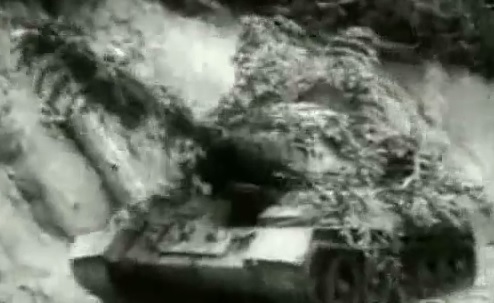
(A North Vietnamese T-34 during the “Route 9” operation.)
The South Vietnamese sent an entire armored brigade, with sixty M41 Walker Bulldog tanks plus a huge number of APCs and artillery pieces.
The brunt of the fighting was done by the PT-76 tanks of the 198th battalion, supported by the T-54/55s of the 297th. Perhaps wisely, the T-34s of the 397th were used as ready-reserves and flank protection, and did not see much fighting.
During the fighting, the USA estimated that the PAVN lost 6 T-54/55 and 17 PT-76 tanks. The North Vietnamese account said that 2 T-54/55s and 6 PT-76s were lost. Notwithstanding the fact that they didn’t see much combat, the WWII-vintage T-34s gave a good account of themselves in that they were completely reliable mechanically, and able to keep up with the modern Cold War-era tanks in the jungle.
The 1971 tank resupply
When President Nixon announced his plan to visit China in February 1972, the Hanoi government was furious at the Chinese. The Soviet Union (hoping to split up North Vietnam’s “triangular” alliance) donated 400 tanks to North Vietnam free of charge. The vast majority were T-54/55s and PT-76s, but an entire additional battalion’s worth (about three to four dozen) of T-34s were also included.
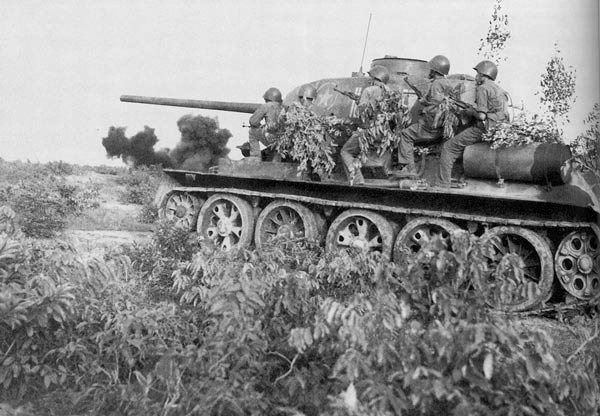
(North Vietnamese soldiers in desant (riding a tank into battle). Desant is frowned upon in the US military but was very common and accepted in communist armies. The soldiers are wearing Soviet SSh-60 helmets which the North Vietnamese used alongside locally-made pith helmets.)

(North Vietnamese T-34 (left) and T-54/55 (right) together on a training course.)
North Vietnamese T-34s in Laos
Besides the “Route 9” defensive operation in southern Laos, North Vietnamese T-34s also fought in the northern region of that country, supporting the Pathet Lao communists in their fight against the Royal Laotian government. In particular, the T-34 saw combat in Laos’s Xieng Khouang province in the early 1970s. Here, the PAVN used them aggressively and without the company of more modern tanks, as the Laotian army’s anti-armor abilities were minimal. The T-34 proved ideal for infantry support, and it’s good reliability allowed extended operations inside Laos.
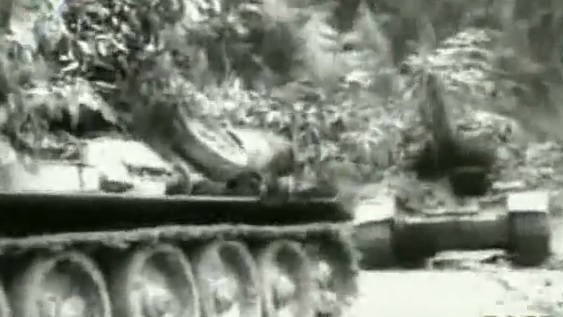
(Camouflaged North Vietnamese T-34s on the move in Laos.)
1972 Easter Offensive
Throughout 1971, the USA and South Vietnam considered the possibility of North Vietnam mounting a traditional-style invasion of South Vietnam using formal tactics as opposed to guerrilla warfare. Because of inter-agency squabbling, the two countries were not prepared for this event when it actually happened in March 1972.
The PAVN invasion force which crossed the DMZ included two full tank regiments, which were a mixture of all three tank types North Vietnam operated. Included in the mix were 60 T-34 tanks.
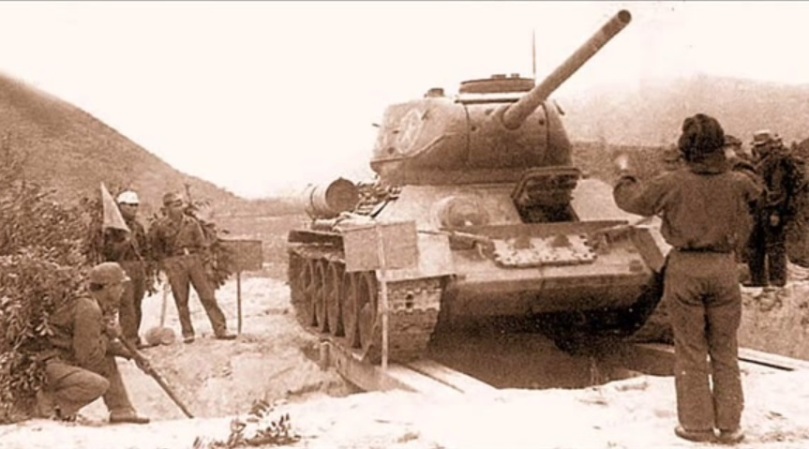
(North Vietnamese T-34 crossing an anti-tank trench via portable beams.)
The Easter Offensive saw the first large-scale use of the AT-3 “Sagger” portable anti-tank missile by North Vietnam. The PAVN quickly appreciated this new weapon and came to regard it as far superior to the RPG-7 and about equal to a tank, when facing South Vietnamese tanks.
A particularly nasty surprise was the 20th Regiment of the ARVN 3rd division at An Loc, which had just reequipped with the M48 Patton. This tank, with it’s 90mm gun and M44 armor-piercing shell, completely outclassed the WWII-vintage T-34 and was at least on par with any other North Vietnamese tanks.
The North Vietnamese invasion initially saw surprising success before bogging down in the summer of 1972. Despite the bumbling leadership of South Vietnam’s generals, ARVN units in the field fought with great tenacity, as did American units. The offensive really began to falter when the USA launched the “Freedom Train” and “Linebacker I” bombing offensives.
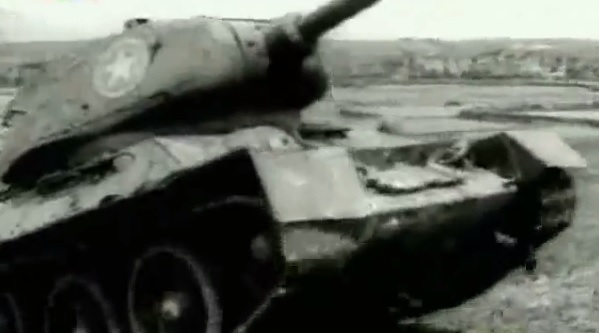
During the early stages of the offensive, the T-34s gave a fairly impressive showing, considering their age. However when the “Linebacker” bombing raids began, an entire battalion of T-34s, thirty in all, were wiped out when they had the misfortune of stopping at a refueling point targeted by B-52 Stratofortresses. Thereafter the remaining T-34s were used as rear-echelon reserves during the gradual retreat northwards back to the DMZ.

(The Soviet WWII-era E-117 tanker’s helmet was standard for North Vietnamese T-34 crewmen.)
North Vietnam lost about forty T-34 tanks during the Easter Offensive. South Vietnam also captured intact one of the Type 63 SPAAG variants. As far as is known, the T-34s did not themselves destroy any South Vietnamese tanks.
The campaign overall was remarkable in that it saw weapons of several generations fighting alongside and against one another: The T-34 and M1 Garand of WWII, the M41 Walker Bulldog of the Korean War, the MiG-17 “Fresco”, AK-47, and T-54/55 of the 1950s, and the M16, F-4 Phantom II, and BGM-71 TOW of the 1960s and 1970s.
End of American involvement
Direct American participation in the war ended in 1973. American tankers never encountered the T-34 and in fact fought pitched tank vs tank battles three times in the whole Vietnam War: In 1968, a M48 Patton of the 3rd Marine Tank Battalion destroyed a PT-76. Besides being the first American tank vs tank kill of the war, the extremely long-range shot was possibly the most distanced kill ever by a M48. A year later, two US Army M48 Pattons destroyed a pair of PT-76s. Finally in 1971, nine M41 Walker Bulldogs of the 11th Armored Cavalry regiment destroyed six T-54s and sixteen PT-76s.
The 1975 Ho Chi Minh campaign and the end of the Vietnam War
In early 1975, North Vietnam decided to test the limits of the Paris cease-fire and began to mount incursions into South Vietnam, to see if the USA, now under President Ford, would intervene to help South Vietnam. When this failed to happen, the North Vietnamese operations changed into a full-scale invasion of South Vietnam which quickly turned into a rout.
T-34 units of the PAVN again saw action, this time against crumbling ARVN infantry units in South Vietnam’s Thua Thien province and in the city of Hue, which had seen earlier battles in the war. In March 1975, T-34s were used effectively in the infantry support role in the capture of Hue. Once again, the old WWII-era tanks served as a force multiplier, freeing up more modern T-54/55s for operations against South Vietnamese tank units further south.
The campaign, and the entire Vietnam War, ended on 30 April 1975 when Saigon was overrun and South Vietnam ceased to exist.

The immediate post-reunification era
During the final 1975 offensive, and with the collapse of South Vietnam thereafter, the PAVN captured immense quantities of American-made weapons, including M41 and M48 tanks. These were immediately integrated into the PAVN. None the less, the aging T-34s were retained in active service. Although now thoroughly obsolete, Vietnam had become hostile to it’s former ally China, and with the war over, the Hanoi government felt that it’s other benefactor, the USSR, would be less generous with military aid – especially “offensive” items like tanks.
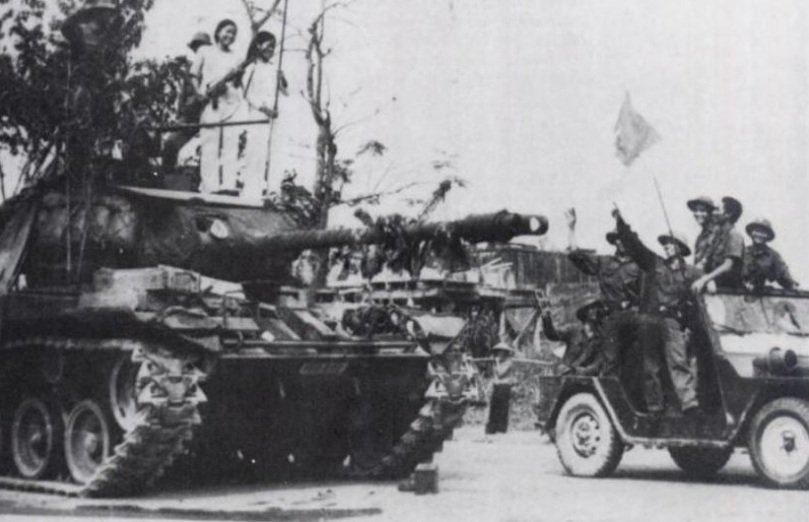
(The influx of American-made vehicles inherited from the defeated South Vietnamese in 1975 eased some of the pressure on T-34 units. This 1975 photo shows a M41 Walker Bulldog tank and M151 MUTT jeep; both captured from South Vietnam.) (photo via Patton Cavalry Museum)
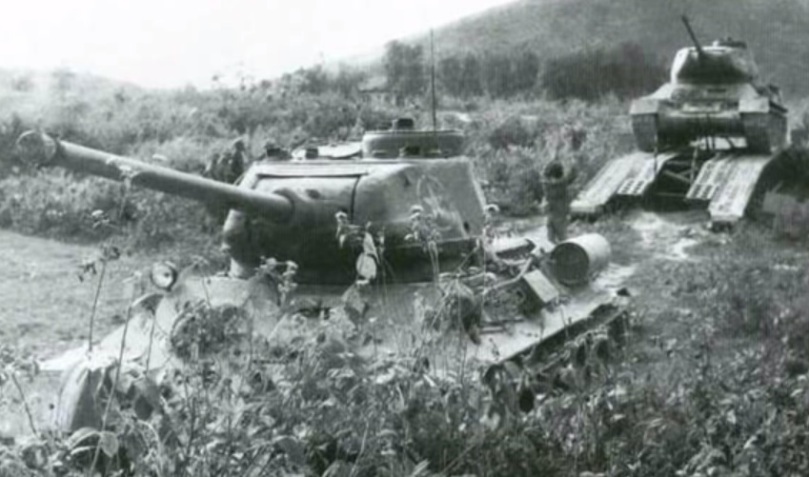
(Vietnamese T-34s during an exercise with bridgelaying vehicles.)
The invasion of Kampuchea
As South Vietnam crumbled in 1975, to the west the communist Khmer Rouge overthrew the Cambodian government and changed the country’s name to Kampuchea. Onetime allies of North Vietnam, the genocidal Khmer Rouge began a racist purge of ethnic Vietnamese people inside their borders and even began mounting small-scale raids against Vietnam.
On 30 April 1977, the second anniversary of the fall of Saigon, Khmer Rouge troops exploited the Vietnamese army’s preparations to celebrate the event by launching a major cross-border raid, which was more barbarian than strategic in nature, resulting in the deaths of hundreds of Vietnamese civilians.
The following twelve months saw increased tension and more sporadic raids into Vietnam. In June 1978, the Vietnamese air force (largely flying American types captured from South Vietnam in 1975) began bombing Khmer Rouge targets inside Kampuchea. Towards the end of the year, the Khmer Rouge began massing a 79,000-man force inside what American GIs had called the Parrot’s Beak during the war; the region of Cambodia which jutted into southern Vietnam.
By then the Hanoi government had run out of patience and launched a preemptive invasion, both to destroy the troop mass in the short term and to end the Khmer Rouge altogether in the longer run. Once again, the T-34 saw service with Vietnam, this time fighting not only alongside the Soviet-made PT-76 and T-54/55, but also American-made ex-ARVN M41 Walker Bulldogs and M113 Gavin APCs.

Initially at least, the Khmer Rouge crumbled and on 7 January 1979 Vietnamese troops entered the capital Phnom Penh. During this initial offensive, the T-34s were generally used as a rolling reserve. Once the formal-style battles ended, the conflict changed into a long, bloody insurgency unsuitable for tanks and the T-34s were withdrawn to northern Vietnam.
The Sino-Vietnamese War
China, which was already estranged from Vietnam, was an ally of the Khmer Rouge and declared the Vietnamese invasion intolerable. China also felt that the USSR, through it’s proxy Vietnam, was encircling southeast Asia. On 17 February 1979 the Chinese army launched an invasion of Vietnam.
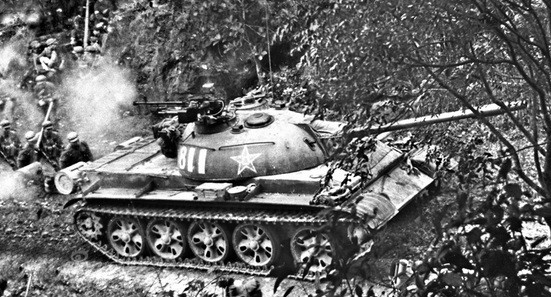
(A Chinese Type 62 during the initial Chinese invasion of Vietnam in February 1979. The 1960s-vintage Type 62 was armed with a high-velocity 62-85TC 85mm gun and was superior in all regards to Vietnam’s WWII-vintage T-34s.)
Now 34 years past the end of WWII, Vietnam’s old T-34s not only again saw combat but during the war’s opening days bore much of the brunt of the fighting, as Vietnam’s more modern tank types were either garrisoned in the former South or tied up in Cambodia.
The Chinese invasion was styled as a pincer-type attack originating from Vietnam’s extreme northwestern and northeastern tips, intending to link up and trap and destroy Vietnamese units in the northern provinces.
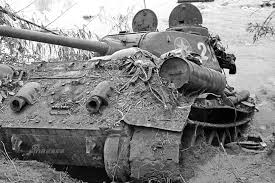
(A Vietnamese T-34 knocked out during the 1979 war with China.)
After an initial spate of success crossing the border, the Chinese advance slowed, despite very weak Vietnamese opposition. Vietnam’s T-34s met Chinese tanks (all more advanced Cold War-era types) at Lang Son, about 12 miles deep into Vietnam. With nothing else available, T-34 tanks led the defense of the town, which finally fell on 5 March 1979 (which was also the day the Chinese decided to end the offensive). During the Lang Son battle, Chinese coordination was atrocious and despite having superior tanks available, they were generally unable to engage the T-34s in tank vs tank combat. None the less, the Vietnamese T-34s suffered significant losses to Chinese artillery and RPG-7 teams. Chinese troops also captured one Vietnamese T-34 intact; it was transported back to Beijing and is today displayed in a museum there.
Vietnam mobilized much faster than China had imagined possible and within days was moving units to the northern part of the country. None the less, the Vietnamese government temporarily evacuated Hanoi.
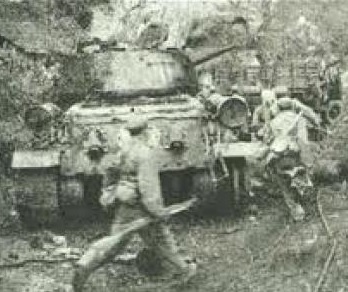
(A Vietnamese T-34 advances to meet the Chinese in 1979.)
On 5 March 1979, China announced it had “achieved it’s objectives” and began a chaotic withdrawal back across the border. The short war ended on 16 March 1979. Both sides declared victory; China stated it had forced the Vietnamese government to flee their capital and had destroyed much of Vietnam’s industrial capacity rebuilt after the Vietnam War. For it’s part, Vietnam continued it’s occupation of Cambodia and inflicted appalling losses on the Chinese army. The latter is particularly true. Despite the element of surprise, a technological advantage, and outnumbering Vietnam 2:1, China suffered personnel losses at a 1:1.5 ratio. During the Lang Son battle alone, China suffered over 10,000 casualties. Of the equipment destroyed, most of the Vietnamese losses were old legacy items (like the T-34) while the Chinese losses were modern, expensive items.

(Chinese infantry pose atop a destroyed Vietnamese T-34 near Lang Son in 1979.)
The war was a very unique instance of the Cold War; one communist country invading another communist country, causing a war with a third communist country. China’s performance overall during the war was terrible, in particular the logistics system was a mess and at several key moments, a chance for a breakthrough victory was lost due to ammunition or fuel shortages. On the other hand, the Vietnamese army showed it had progressed beyond the guerrilla tactics of the Vietnam War and was now a de jure traditional army.
Vietnamese T-34s in the 1980s, 1990s, and 21st century
Surprisingly the T-34s which survived the brief war against China remained in service. Now a design four decades old, the WWII-vintage T-34s were pulled from dedicated armor units and instead assigned to the organic tank platoons attached to infantry and motor rifle units.
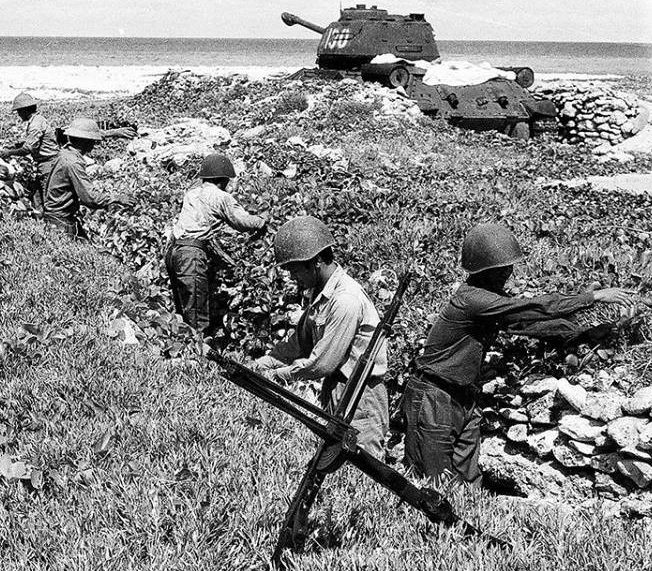
(Vietnamese troops dig in next to a T-34 during a 1988 anti-invasion exercise.)
By the 1990s, about five dozen were still in use. They were mostly used as OPFOR vehicles during the 1990s through the turn of the millennium. Vietnam was one of a limited number of countries still fielding the WWII-era T-34 past the year 2000.

(Vietnamese T-34 during an infantry support exercise.)
An exception is Vietnam’s claim to Truong Sa, one of the tiny Spratly Islands which lie far from the Vietnamese mainland, about midways between Borneo and the Philippines. The whole island chain is disputed between five different countries and the tiny atolls, islets, and sandbars are divided among them. A very small number of T-34s are stationed on Truong Sa. For Vietnam, transporting tanks that far is a major task which requires the use of WWII-vintage American-made amphibious ships inherited from the defunct South Vietnamese navy in 1975. Vietnam apparently feels that the handful of T-34s on the islet are sufficient and not worth the expense of exchanging them for more modern types.

(A Vietnamese T-34 in the Spratlys fires it’s 85mm gun during a 2012 exercise.)
By 2010, only four dozen T-34s remained in Vietnamese use. They were formally placed in lay-up or discarded that year; with the exception of those in the Spratly Islands.
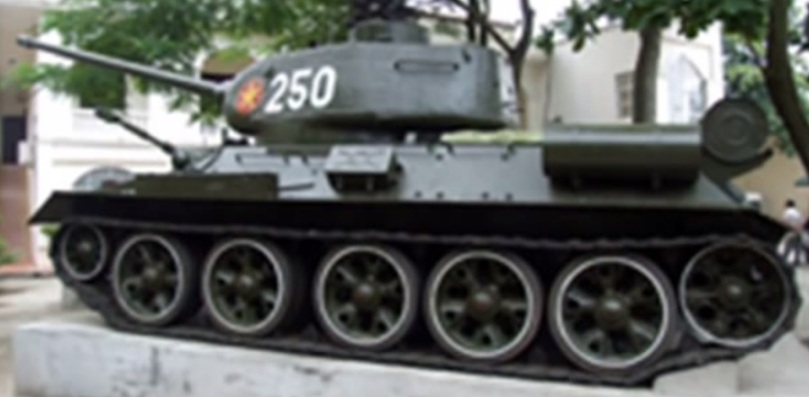
(A retired T-34 preserved as a monument in Vietnam.)

[…] Source: The T-34 in Vietnam […]
LikeLike
Impressive!
LikeLiked by 1 person
As regards: A North Vietnamese PT-76 which was knock…
I think you misidentified this tank. the one in the picture seems to be this:
#/media/File:Type_63_tank_-_above.jpg)
It was also used by Commie Vietnam. I congratulate you on your glorious website!
LikeLike
Yes you are correct, it does appear to be the PRC’s Type 63 version.
LikeLike
The “PT-76” is actually a Chinese Type 63, a hybrid with the chassis of PT-76 and the turret of Type 62 light tank, armed with an 85mm gun.
LikeLike
Yes it appears you are correct, good catch!
LikeLike
There’s no vehicle called the Gavin.
LikeLike
This is the semi-official name for the M113 armored personnel carrier. Many of the Army’s systems popular names are only quasi-official.
LikeLike
No it is not. THERE IS NO SUCH THING AS A “GAVIN.”
Clearly you never served in the US Army in any unit that used M113s. NO ONE — and I speak as a retired NCO with more than two decades driving 113s — ever called them a “Gavin.”
The ONLY source for that bullshit term is washed-out failure Michael P Sparks, who NEVER served in a unit using M113s. Even the most cursory internet search for “Gavin” and “Mike Sparks” will amply document that he is the sole source of this disinformation, and that he conducted a long and mentally-deranged campaign to force this nonsense into the history books.
Frankly, if your “research” is so inadequate on this topic, then it calls into question everything else you’re attempting here. What other nonsense and delusions are you putting forth as “fact”?
LikeLike
[…] Military Aid Deliveries to North Vietnam During 1968 (A declassified CIA report dated May 1969). worldwariiafterworldwarii.wordpress Special thanks to the members of the ‘T-34 Interest Group’ on Facebook for their […]
LikeLike
[…] Eastern Front during World War II. After delivery to Vietnam, they could have seen further action against South Vietnam and its U.S. allies, or against the Americans and their partners in neighboring Laos. That […]
LikeLike
[…] https://wwiiafterwwii.wordpress.com/2016/01/14/the-t-34-in-vietnam/ […]
LikeLike